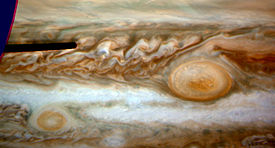Oval BA

Oval BA (commonly known as Red Spot Jr., Red Jr. or the Little Red Spot) is the South Temperate Belt (STB) spot of the planet Jupiter. The only remnant atmospheric feature of what were once the three white ovals FA, BC, and DE, Oval BA is currently half the size of the Great Red Spot and continues to grow.
Origins and mechanics
The formation of the white ovals can be traced to 1939, when the South Temperate Zone was rent by dark features that effectively split the zone into three long sections. Jovian observer Elmer J. Reese labeled the dark sections AB, CD, and EF. The rifts expanded, shrinking the remaining segments of the STZ into the white ovals FA, BC, and DE.[1]
The white ovals covered almost 90 degrees of longitude shortly after their formation, but contracted rapidly during their first decade; their length stabilized at 10 degrees or less after 1965.[2] Although they originated as segments of the STZ, they evolved to become completely embedded in the South Temperate Belt, suggesting that they moved north, "digging" a niche into the STB.[3] Indeed, much like the GRS, their circulations were confined by two opposing jet streams on their northern and southern boundaries, with an eastward jet to their north and a retrograde westward one to the south.[4]
The longitudinal movement of the ovals seemed to be influenced by two factors: Jupiter's position in its orbit (becoming faster at aphelion), and by proximity to the GRS (accelerating when within 50 degrees of the Spot).[5] The overall trend of the white oval drift rate was deceleration, with a decrease by half between 1940 and 1990.[6]
During the Voyager fly-bys, the ovals extended roughly 9000 km from east to west, and 5000 km from north to south, and rotated every five days (cp. six for the GRS at the time).[7]
Formation and discovery
Ovals BC and DE merged in 1998, forming Oval BE. Then, in March 2000, BE and FA joined together, forming Oval BA.
During August 2005, Oval BA slowly began to turn red as shown in amateur images. The change was not noticed at the time because it was slight and Jupiter was close to solar conjunction. The change was prominent on December 2005 after solar conjunction. On February 24, 2006, Filipino amateur astronomer Christopher Go discovered the change in color and alerted the ALPO Jupiter Section. Richard Schmude Jr., ALPO Jupiter Section coordinator, using the archives of ALPO Japan Kansai division confirmed the change. The color was still becoming more intense during these months. In March 2006, it was apparently the same color as the GRS.
Dr. Tony Phillips coined the term "Red Spot Jr." or "Red Jr." but professionals still call it Oval BA.[8] The New Horizons team refer to it exclusively as the "Little Red Spot" [9]
Current observations
In April 2006, a group of professional astronomers led by Dr. Amy Simon-Miller (NASA GSFC), Dr Imke de Pater and Dr Phil Marcus (UC Berkeley) used the Hubble Space Telescope to image both the Great Red Spot and Oval BA. Other professional and amateur astronomers have collaborated with this project by imaging the Great Red Spot and Oval BA from ground-based telescopes. As of June 5 2006, the team discovered that the Great Red Spot and Oval BA might converge, according to a report on the NASA Science website.
The storms pass each other about every two years, but the passings of 2002 and 2004 did not produce anything exciting. In July 2006, astronomers at Gemini North photographed a near collision between Oval BA and the Great Red Spot. The two storms once again did not converge.
In February 2007 the New Horizons fly-by of Jupiter (enroute to Pluto) got the closest look yet at Oval BA for the first time as a red spot.
Oval BA is getting stronger according to recent studies with the Hubble Space Telescope. The wind speeds have reached the 400 mph (645 km/h) mark, which, according to NASA, is about the same as the Great Red Spot. Its current size is about the diameter of Earth.
Footnotes
- ^ John Rogers, The Giant Planet Jupiter, (Cambridge: Press Syndicate of the University of Cambridge, 1995), p. 223.
- ^ Rogers, p. 224-5.
- ^ Rogers, p. 226-7.
- ^ Rogers, p. 224-5.
- ^ Rogers, p. 226.
- ^ Rogers, p. 225.
- ^ Reta Beebe, Jupiter: The Giant Planet (Smithsonian Institution 1997), p. 43.
- ^ http://www.redspotjr.com/
- ^ LORRI Takes an Even Closer Look at the Little Red Spot
See also
- Cloud pattern on Jupiter
- Extraterrestrial cyclones
- Great Dark Spot
- Small Dark Spot
- Dragon Storm (astronomy)
External links
- A mosaic of three New Horizons images of Jupiter's Little Red Spot, taken with the spacecraft's Long Range Reconnaissance Imager (LORRI) camera on February 26, 2007
- NASA's Astronomy Picture of the Day -- "Jupiter's Two Largest Storms Nearly Collide"
- NASA: Jupiter's New Red Spot
- NASA: Huge Storms About To Converge
- Hubble Space Telescope Image Gallery
- Jupiter 2006
- Website of Red Spot Jr.
- SPACE.com: Surprise! Jupiter Has A New Red Spot
- New Red Spot Growing Fast On Jupiter
